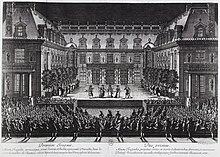Court festival (feudalism)
Farm festivals or court resistant to royal yards from the Middle Ages , on the Early Modern to the beginning of the modern era , which served representation of the power of the relevant ruler and stabilize the hierarchical socio feudal rule system .
features
In addition to the invitations and the preparations for the festivities, arrangements had to be made for the accommodation of the guests. Court festivals caused high financial expenses for the organizing courts.
Courtyard festivals had ceremonially regulated processes. The arrival of the guests at the court was like a solemn procession. The greeting was designed as a ritualized procedure, such as kneeling , bowing , hugging and kissing .
Catering was taken care of. There were festive programs to entertain the guests . So instrumental music and singing were used, artists showed their tricks or trainers presented trained animals. From the early modern era, fireworks were increasingly used as a festival highlight. An expectation-oriented gift diplomacy from the organizer to the guests was part of the ritual context of the court festivals.
Knight tournaments and hunting were more often part of court festivals. Also, masked balls , dance balls , opera and theater performances belonged to it.
History of the court festivals
There were splendid celebrations in all feudal societies . Whether at the courts of the French Capetians , the English Plantagenets or the German-Roman emperors, what they all had in common was the splendid design of the festivities, which served the purpose of demonstrating wealth, but also strength and superiority. It is known about the court festivals of Friedrich Barbarossa from Staufer that more than 1,000 people were among the guests on several occasions. For their accommodation during the festive season, luxurious tents were set up or even buildings built just for the occasion were used. One such large-scale festival was the Mainzer Hoftag of 1184 , on the occasion of which the sons of Friedrich Barbarossa were led to the sword.
Court festivals in the Middle Ages usually took place on high Christian holidays. Culture, rule and religion were thus connected.
Typical occasions for court festivals were court days, coronation celebrations, weddings, sword guiding , peace treaties, church holidays.
In Upper Austria a comparable magnificent event in the late Middle Ages took place: On May 26, 1521 married in Linz grandson Ferdinand, Emperor Maximilian I , Anna , the daughter of the King of Bohemia and Hungary, the so-called Linzer wedding (see also. Wiener Double wedding ). In the course of the celebrations, the so-called Losenstein tournament was also held.
In the Baroque era , the festivities at the Versailles court were considered a highlight of European court culture . They also served to keep the largely disempowered court nobility bound to the ruling house. In the Augustan age , the court festivals of the Saxon court became well -known across the region . The Saturnus Festival , for example, became known . In contrast, the court festivals of the Prussian court remained familial. There were revues important part of the festival program.
In the 19th century the courts lost their central political function for their societies. Court celebrations retained their festive character and, particularly in the Second German Empire during the reign of Kaiser Wilhelm II, showed features of Byzantinism .
Web link
- Courtly culture in the Middle Ages in the forum OoeGeschichte.at
literature
- Lisa Pychlau-Ezli: Eating and drinking in the Middle Ages: The alimentary code in the Middle High German epic. Vandenhoeck & Ruprecht, 2018.
Individual evidence
- ↑ Lisa Pychlau-Ezli: Eating and drinking in the Middle Ages: The alimentary code in the Middle High German epic. Vandenhoeck & Ruprecht, 2018, p. 65
- ↑ Lisa Pychlau-Ezli: Eating and drinking in the Middle Ages: The alimentary code in the Middle High German epic. Vandenhoeck & Ruprecht, 2018, p. 63
- ↑ Lisa Pychlau-Ezli: Eating and drinking in the Middle Ages: The alimentary code in the Middle High German epic. Vandenhoeck & Ruprecht, 2018, p. 64


